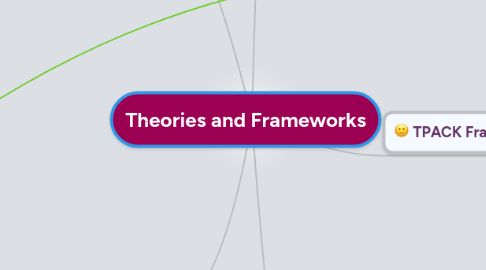
1. Cognitive Load
1.1. Processing information can overload or underload working memory, and learning will not take place in either case
1.2. 2 types of memory: working memory and long-term memory
1.3. 3 Types of C.L.
1.3.1. Extraneous-imposed by outside world, the manner in the information is presented
1.3.2. Intrinsic- imposed by learning task; there is only so much information one can intake and retain at a given moment
1.3.3. Germane-information connects to one's own schemas
1.4. Teachers need to be aware of the format and technology they use to present information, as well as chunk information into logical sections that do not overload or overstimulate their students
2. Learning Theories
2.1. Constuctivism
2.1.1. Learning is about building connection by actively interacting with their environment
2.1.2. Begin with complex problems and teach basic skills while solving these problems (scaffolding)
2.1.3. Involves constructing one's own knowledge from one's own experiences
2.1.4. Teachers are important as facilitators in helping their students make meaningful connections
2.1.5. Involves Discovery Learning, collaboration and authentic learning environments
2.1.6. Hands-on learning
2.1.7. eg: LEGO ROBOTICS!!!
2.1.7.1. Visual example
2.2. Connectivism
2.2.1. A learning theory for the digital age
2.2.2. Build a network of connections
2.2.3. Finding/having a source for any kind of information; like Barry from 'Storage Wars', "I've got a guy for everything"
2.2.4. Learning consists of the ability to construct and transverse these networks, of people or digital networks
2.2.5. Knowledge is the set of connections formed by experiences and sources of information: building a Personal Learning Network (PLN)
2.2.6. A theory that is current, up-to-date
2.2.7. Enables a diversity of answers and responses
2.2.8. One's capacity to learn and seek information is more critical than present knowledge
2.2.9. The ability to see connections
2.2.10. Social Networking: Facebook, Twitter, MySpace, Search Engines, Discussion Forums, Webcams, Email, Skype, etc.
2.2.10.1. Are students becoming dependant on these resources/technologies to communicate?
3. Philosophy of Teachnology
3.1. Philosophy of Teachnology is personal; it is my opinion about how I can integrate technology into my classroom.
3.1.1. This includes my teaching style, such as lecturing using PowerPoint slides, or interactive videos, or computer-aided tools, etc.
3.2. My Personal Learning Network (PLN) will reflect my opinions about technology and its usefulness
3.3. Includes my fears or concerns, or criticisms about technology.
3.4. I can physically record my Philosophy of Teachnology or simply reflect internally
3.5. Perceptions of how I plan to use technology while teaching, what I am currently knowledgable about and what I would like to learn more about
3.6. Here are some examples of beliefs about technology in Education
3.6.1. 1
3.6.2. 2
3.6.3. 3
3.6.4. 4
4. TPACK Framework
4.1. It is important for teachers to have 3 types of knowledge.
4.1.1. Content
4.1.2. Pedagogical
4.1.3. Technology
4.2. TPACK comes from the crossover that exists between all three types of knowledge when all are used and valued in the classroom, and a teacher's philosophy of teaching.
4.2.1. This is typically shown using a Venn Diagram
4.3. The ability to successfully integrate technology into a teacher's style of instruction will develop overtime, as they become more confident in their capacity to use the technology effectively, the extent to which they know their content, and their confidence in teaching this content in a meaningful manner.
5. Technology Theories
5.1. S.C.O.T.
5.1.1. Social Construction of Theory
5.1.2. "technology does not determine human action, but that rather, human action shapes technology." Wiki
5.1.3. also a methodology: when analyzing the successes and failures of technologies
5.1.4. Certain technologies persist because of their convenience, rather than their optimal utility or effectiveness, much like certain adaptations/persisting mutations in the Animal Kingdom, such as the male peacock's giant colourful tail. It serves no physiological advantage, but attracts females, which increases their level of fitness and thus the gene persists.
5.1.5. Analysis of technology and its use for humans
5.2. Media Ecology
5.2.1. the study of media environments and their influence on human behaviour
5.2.2. A scientific-like viewpoint that argues that media drives societal patterns, where as SCOT argues that humans drive technological development
5.2.3. Is there a SuperRobot Computer who is actually controlling the human population while making it seem as if we actually have control?
5.2.4. Media Communication influences human perception, feeling, interpersonal interaction
